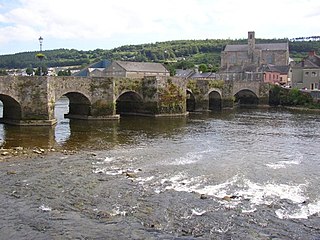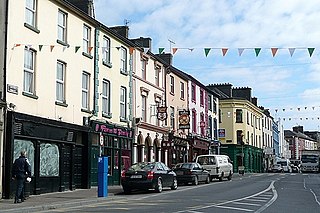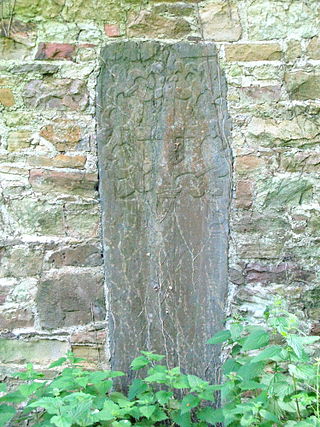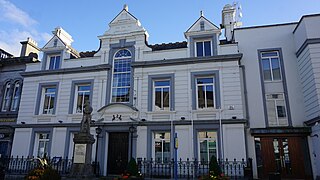
Cahir is a town in County Tipperary in Ireland. It is also a civil parish in the barony of Iffa and Offa West.

Nenagh is the county town of County Tipperary in Ireland. Nenagh used to be a market town, and the site of the East Munster Ormond Fair.

Clonmel is the county town and largest settlement of County Tipperary, Ireland. The town is noted in Irish history for its resistance to the Cromwellian army which sacked the towns of Drogheda and Wexford. With the exception of the townland of Suir Island, most of the borough is situated in the civil parish of "St Mary's" which is part of the ancient barony of Iffa and Offa East.

Roscrea is a market town in County Tipperary, Ireland. In 2022 it had a population of 5,542. Roscrea is one of the oldest towns in Ireland, having developed around the 7th century monastery of Saint Crónán of Roscrea, parts of which remain preserved today. The town is in a civil parish of the same name.

Carrick-on-Suir is a town in County Tipperary, Ireland. It lies on both banks of the River Suir. The part on the north bank of the Suir lies in the civil parish of "Carrick", in the historical barony of Iffa and Offa East. The part on the south bank lies in the civil parish of Kilmolerin in the barony of Upperthird, County Waterford.

Fethard is a small town in County Tipperary, Ireland. Dating to the Norman invasion of Ireland, the town's walls were first laid-out in the 13th century, with some sections of these defensive fortifications surviving today.

Tipperary, commonly known as Tipperary Town, is a town and a civil parish in County Tipperary, Ireland. Its population was 4,979 at the 2016 census. It is also an ecclesiastical parish in the Roman Catholic Archdiocese of Cashel and Emly, and is in the historical barony of Clanwilliam. The town gave its name to County Tipperary.
County Tipperary was a parliamentary constituency in Ireland, which from 1801 to 1885 returned two Members of Parliament (MPs) to the House of Commons of the United Kingdom.

Father Nicholas Sheehy (1728–1766) was an 18th-century Irish Roman Catholic priest who was executed on the charge of being an accessory to murder. Father Sheehy was a prominent and vocal opponent of the Penal Laws, which subjected the whole Catholic Church in Ireland to religious persecution, and as a vocal activist for Catholic Emancipation. His conviction was widely regarded as a judicial murder and was cited long afterwards as Irish jargon for a miscarriage of justice. Fr. Nicholas Sheehy is currently regarded as one of the Irish Catholic Martyrs.

Tubrid or Tubbrid is a civil and former ecclesiastical parish situated between the towns of Cahir and Clogheen in County Tipperary, Ireland. A cluster of architectural remains at the old settlement still known as Tubrid includes an ancient cemetery and two ruined churches of regional historical significance.

Inislounaght Abbey, also referred to as Innislounaght, Inislounacht and De Surio, was a 12th-century Cistercian settlement on the river Suir, near Clonmel in County Tipperary, Ireland. It was originally dedicated to the Blessed Virgin.

Moorstown Castle is a late 15th-century stone structure consisting of an enclosed circular keep near Clonmel, County Tipperary, Ireland.

Roscrea Castle is a 13th-century motte-and-bailey castle in the town of Roscrea, Ireland. The castle consists of a walled courtyard, gate block, and angled towers. Along with 18th century Damer House and gardens, the castle forms part of Roscrea Heritage Centre.

The Priory of St. Mary in Cahir, known as Cahir Abbey, was a medieval priory of Augustinian Canons regular and is a National Monument located in Cahir, Ireland.

Isert Kelly Castle is a tower house and National Monument located in County Galway, Ireland.

Clonmel Courthouse was a judicial facility in Clonmel, County Tipperary, Ireland.

The Tipperary Museum of Hidden History is a local history museum in Clonmel, County Tipperary, Ireland. It is designated as museum by the National Museum of Ireland and has full accreditation in the Museum Standards Programme for Ireland (MSPI).

Clonmel Town Hall is a municipal building in Parnell Street, Clonmel, County Tipperary, Ireland. The building accommodated the offices of Clonmel Borough Council until 2014.

The Church of the Sacred Heart is an 1838 Catholic church in Oola, Ireland.





















